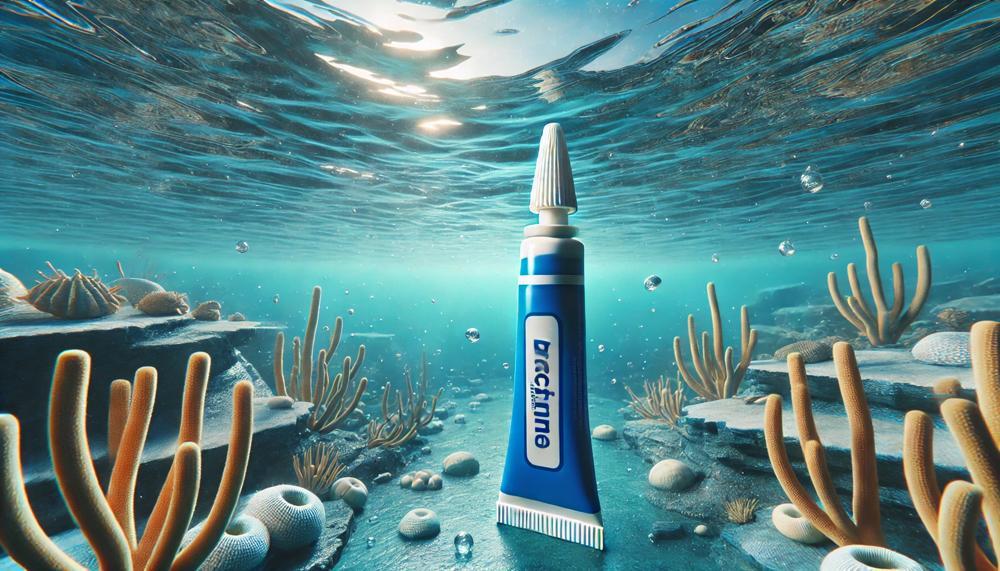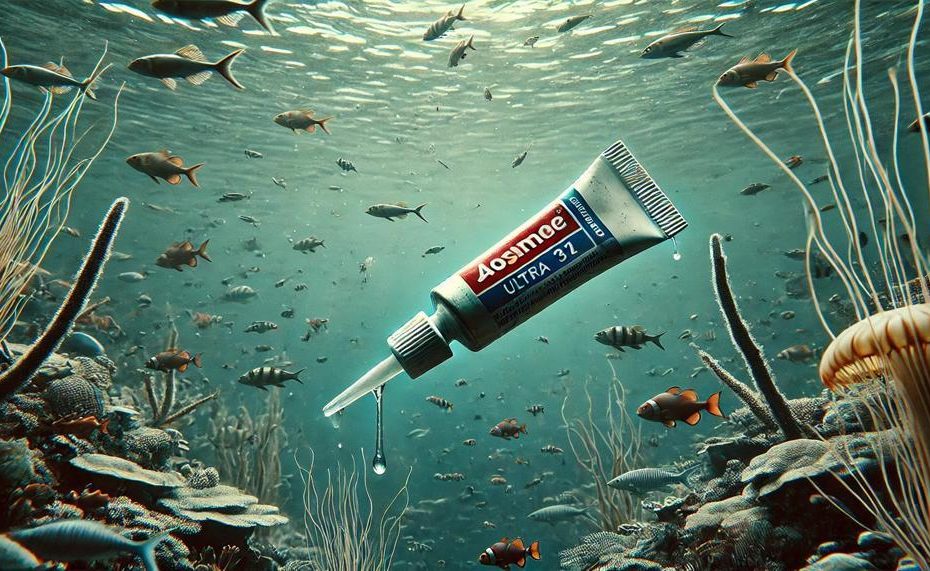The underwater world presents unique challenges, and the question of whether glue can stick in such an environment is a fascinating one. The short answer is: yes, certain types of glue can stick underwater, but not all adhesives are created equal when it comes to aquatic applications.
Here are the key takeaways:
- Not all adhesives can withstand the demands of an underwater environment. Standard glues like white school glue or wood glue will quickly dissolve and lose their adhesive properties.
- There are specialized underwater adhesives designed to form a strong, durable bond even when fully submerged. These include epoxy, marine sealant, polyurethane sealant, silicone sealant, and butyl tape.
- Factors like the materials being bonded, water temperature, project duration, and depth of water all play a role in determining the appropriate underwater glue for a given situation.
- Proper surface preparation is crucial for achieving a successful underwater bond, as the presence of water can interfere with adhesion.
Whether you’re a professional diver, a boat enthusiast, or simply someone with a curiosity about the underwater world, understanding the capabilities and limitations of underwater adhesives opens up a realm of possibilities. From repairing underwater equipment to constructing aquatic structures, the right glue can make all the difference in conquering the challenges of the deep.
Table of Contents [show]
What is the Best Aquarium-Safe Glue?
When selecting an aquarium-safe glue, the foremost consideration is its non-toxicity and safety for aquatic life. The adhesive must be explicitly labeled as “aquarium-safe” or “reef-safe” to ensure it won’t leach harmful chemicals into the water, compromising the health of your finned friends. Additionally, the glue should be waterproof and capable of withstanding the harsh, wet conditions within an aquarium.
| Key Factors | Description | Examples |
| Non-toxic | Safe for aquatic creatures, won’t contaminate the water | Silicone, cyanoacrylate, epoxy resin |
| Waterproof | Able to cure and bond underwater without degrading | Marine-grade epoxy, aquarium-safe silicone |
| Intended Use | Suitable for the specific application (sealing, bonding, decorations) | Cyanoacrylate for live rock, silicone for sealing |
To effectively bond underwater, meticulous surface preparation is paramount. Ensure the surfaces are clean, dry, and free of any contaminants that could impede adhesion. Apply the glue sparingly, following the manufacturer’s instructions, and allow ample time for curing – typically at least 48 hours. Using too much adhesive can cloud the water or harm aquatic pets, so moderation is key.
Aquarium-safe glues offer the invaluable benefit of providing a secure, reliable bond without jeopardizing the well-being of your aquatic ecosystem. Whether you’re sealing a leak, bonding decorations, or attaching live rock, these specialized adhesives are versatile enough for use in both freshwater and saltwater aquariums. By prioritizing the safety of your finned companions and adhering to proper application techniques, you can create a thriving, well-maintained underwater haven.
For credible sources and further reading, check out these trusted resources:

What are the Aquarium Adhesive Types?
Maintaining an aquarium often requires securing various components, creating decorations, or repairing equipment, and the right adhesive is crucial for these tasks. Here are the different types of adhesives suitable for use in aquariums:
| Adhesive Type | Description | Ideal Uses |
| Cyanoacrylate (Super Glue) | A fast-drying, clear adhesive that forms a strong bond between surfaces. Aquarium-safe varieties are available. | Attaching decorations, securing equipment, and sealing small leaks or cracks. |
| Silicone Sealant | A flexible, waterproof sealant that remains pliable after curing. Non-toxic silicone varieties are recommended for aquarium use. | Sealing aquarium seams, bonding glass or acrylic panels, and securing equipment or decorations. |
| Epoxy Putty | A two-part adhesive that forms a durable, waterproof bond when mixed. Designed for underwater applications. | Repairing cracks or holes in aquarium surfaces, bonding decorations or equipment, and creating custom aquascapes. |
It’s important to note that not all adhesives are safe for aquarium use, as some can leach harmful chemicals into the water. Always choose products specifically labeled as aquarium-safe or designed for underwater applications. Additionally, proper surface preparation and following the manufacturer’s instructions are crucial for ensuring a strong, long-lasting bond.
The 8 Best Aquarium-Safe Glue Options
Here are the top 8 aquarium-safe glue options:
| Glue Type | Description | Best For |
|---|---|---|
| Silicone Sealant | A flexible, waterproof adhesive that cures with air exposure. Look for 100% silicone formulas labeled as aquarium-safe. | Sealing aquarium seams, attaching decorations, repairing leaks. |
| Cyanoacrylate (Super Glue) | A fast-curing, clear adhesive suitable for bonding porous materials. Gel formulas are best for aquarium use. | Attaching live rock, corals, and decorations. Avoid for sealing seams. |
| Epoxy Putty | A two-part adhesive that cures into a durable, waterproof bond. Choose non-toxic, aquarium-safe formulas. | Repairing cracks, bonding decorations, and creating structures. |
| Aquarium-Safe Hot Glue | A specialized hot glue designed for underwater use without leaching toxins. | Attaching decorations, securing equipment, and temporary repairs. |
| Aquarium-Safe Epoxy Resin | A two-part resin that cures into a clear, waterproof bond. Look for non-toxic, aquarium-safe formulas. | Bonding decorations, repairing cracks, and creating custom structures. |
| Aquarium-Safe Acrylic Cement | A solvent-based adhesive specifically designed for bonding acrylic aquarium panels. | Repairing cracks, sealing seams, and bonding acrylic components. |
Characteristics of Aquarium-Safe Glue
Aquarium-safe glues possess unique characteristics that allow them to adhere securely underwater while remaining non-toxic to aquatic life. The key factors that make a glue aquarium-safe and able to stick submerged are:
| Waterproof and Water-Resistant | Aquarium-safe glues are designed to cure and maintain their adhesive properties even when fully submerged in water, ensuring a long-lasting bond. | |
| Non-Toxic Formula | These glues are formulated without harmful chemicals, solvents, or additives that could leach into the water and harm fish, plants, or other aquatic inhabitants. | |
| Safe for Aquatic Life | Manufacturers of aquarium-safe glues ensure their products are thoroughly tested and certified as non-toxic, making them safe for use in freshwater and saltwater environments. | |
| Curing Process | Some aquarium-safe glues cure through a chemical reaction, while others rely on exposure to air or moisture to set. | The curing process is carefully designed to ensure the glue remains stable and maintains its bond underwater. |
| Bonding Strength | Despite their non-toxic nature, aquarium-safe glues offer excellent bonding strength, allowing them to securely adhere various materials like glass, acrylic, and decorations. | |
| Clarity | Many aquarium-safe glues are clear or tinted to blend seamlessly with the aquarium environment, ensuring a discreet and aesthetically pleasing bond. | |
By combining these key characteristics, aquarium-safe glues provide a reliable and secure bonding solution for underwater applications, ensuring the safety of aquatic life while maintaining the integrity of the aquarium setup.
How to Use Aquarium Adhesives
Aquarium adhesives are specially formulated to be waterproof, non-toxic, and able to withstand harsh aquatic conditions. Here are the main types and their recommended uses for underwater applications:
| Adhesive Type | Description | Underwater Uses |
|---|---|---|
| Silicone Adhesive | Flexible, waterproof sealant ideal for bonding glass, plastic, and other non-porous materials. | Sealing aquarium seams, bonding decorations, attaching equipment like heaters or filters. |
| Cyanoacrylate Glue | Fast-curing, super-strong adhesive that bonds well to porous and non-porous surfaces. | Attaching live rocks, corals, or other aquarium decorations. Quick repairs on cracked aquariums. |
| Epoxy Resin Adhesive | Two-part adhesive that cures into an extremely durable, waterproof bond when mixed. | Fixing leaks, creating custom structures like overflows or sumps, bonding large aquarium pieces. |
When using these adhesives underwater, proper surface preparation is crucial. Surfaces must be clean, dry, and free of any contaminants for the glue to adhere properly. Follow product instructions carefully, as cure times and application methods may vary.
For extended underwater projects, opt for epoxy or silicone adhesives known for their longevity and resistance to degradation. Cyanoacrylates may be better suited for quick, temporary fixes. Always use aquarium-safe products and ensure adequate ventilation when working with adhesives.
By choosing the right adhesive and using it correctly, you can create secure, long-lasting bonds in your underwater aquarium environment.
Can You Glue Aquarium Plants?
Yes, it is possible to use specialized aquarium-safe glues to attach aquarium plants in an underwater environment. However, it is crucial to choose the right type of glue and follow proper application techniques to ensure the safety of your aquatic life and the long-term success of your planted aquarium.
| Aquarium-Safe Glue Types | Suitable For | Considerations |
| Cyanoacrylate-based (super glue) | Attaching anubias, java fern, moss, and other epiphytic plants to driftwood or decorations | Apply in a well-ventilated area, use sparingly, and avoid direct contact with water until fully cured |
| Silicone-based | Securing rhizome plants like anubias and java fern to rocks or hardscape | Ensure the silicone is aquarium-safe, non-toxic, and cures fully before submerging |
| Epoxy resins | Gluing plants to hardscape or attaching plant weights | Use specialized aquarium-safe epoxy, follow curing instructions, and avoid direct contact with water until fully cured |
When using aquarium-safe glues, it is crucial to follow the manufacturer’s instructions carefully, ensuring proper surface preparation and allowing ample time for the adhesive to cure before submerging it in water. Excessive use of glue can potentially harm aquatic life, so it should be applied sparingly and precisely. Additionally, aquarium enthusiasts recommend testing the glue in a separate container before using it in the main aquarium to ensure its safety and compatibility.
Ultimately, while gluing aquarium plants can be a viable option, many experienced aquarists prefer alternative methods such as using plant weights, tying plants to hardscape, or using specialized plant anchors to secure their aquatic plants.
How to Glue Aquarium Rocks Together
Yes, you can effectively glue aquarium rocks together underwater using aquarium-safe adhesives designed for underwater applications. The key is to choose the right type of waterproof and non-toxic glue suitable for aquarium environments. Here are some tips for gluing aquarium rocks together:
| Suitable Adhesives | Epoxy, marine sealant, polyurethane sealant, silicone sealant, and butyl tape are good options for underwater rock bonding. | Epoxy is often considered the best choice due to its strength and durability. |
| Surface Preparation | Ensure the rock surfaces are clean, dry, and free of debris before applying the adhesive. | Rough up the surfaces slightly for better adhesion. |
| Application | Apply a thin, even layer of the adhesive to both rock surfaces. | Press the rocks together firmly and hold them in place until the adhesive sets, following the manufacturer’s instructions. |
By using the right underwater adhesive and following proper application techniques, you can create a stable and visually appealing aquascape with securely bonded rocks. Always check that the adhesive is aquarium-safe and non-toxic to ensure the safety of your aquatic life.
What is the Best Aquarium-Safe Glue for Me?
| Factor | Description | Importance |
| Aquatic Safety | The glue must be non-toxic and safe for aquatic life, including fish, plants, and invertebrates. It should not leach harmful chemicals into the water. | Paramount |
| Water Resistance | The adhesive should be able to withstand prolonged submersion in water without degrading or losing its bonding strength. | Crucial |
| Material Compatibility | The glue should be compatible with the materials you plan to bond, such as glass, acrylic, stone, or plastic, ensuring a strong and lasting bond. | Essential |
| Curing Time | Consider the curing time of the glue, as some may require extended periods before being fully submerged or achieving maximum bond strength. | Important |
| Ease of Use | Evaluate the application method and any special requirements, such as surface preparation or clamping, to ensure a successful bond. | Beneficial |
| Clarity | If visibility is important, choose a clear or translucent glue that won’t detract from the aesthetic appeal of your aquascape. | Desirable |
Prioritizing aquatic safety and water resistance is crucial when selecting an aquarium-safe glue. Compatibility with your materials and ease of use are also important factors to consider. By carefully evaluating these aspects, you can ensure a strong, long-lasting bond while maintaining a healthy and visually appealing underwater environment for your aquatic inhabitants.
Conclusion
The underwater realm presents unique challenges, but modern adhesives have risen to meet them head-on. As we’ve explored, specialized glues designed for aquatic applications can indeed form tenacious bonds beneath the waves. From heavy-duty epoxies and marine-grade sealants to flexible silicones, these underwater adhesives offer an array of solutions for tackling submerged projects.
Their waterproof, non-toxic formulations allow them to cure fully immersed, securely bonding materials like glass, acrylic, and stone without compromising the delicate aquatic ecosystem. Meticulous surface preparation is key to ensuring maximum adhesion, as is precisely following the manufacturer’s guidance on application and curing times.
Whether repairing critical equipment, constructing underwater structures, or crafting stunning aquascapes, the right underwater adhesive can unlock a world of possibilities. These specialized glues empower us to conquer the challenges of the deep, enabling secure, long-lasting bonds that defy the aquatic environment’s harsh conditions.
So for those eager to explore the underwater frontier, be it professional or personal pursuits, equipping yourself with the knowledge of underwater adhesives is vital.






